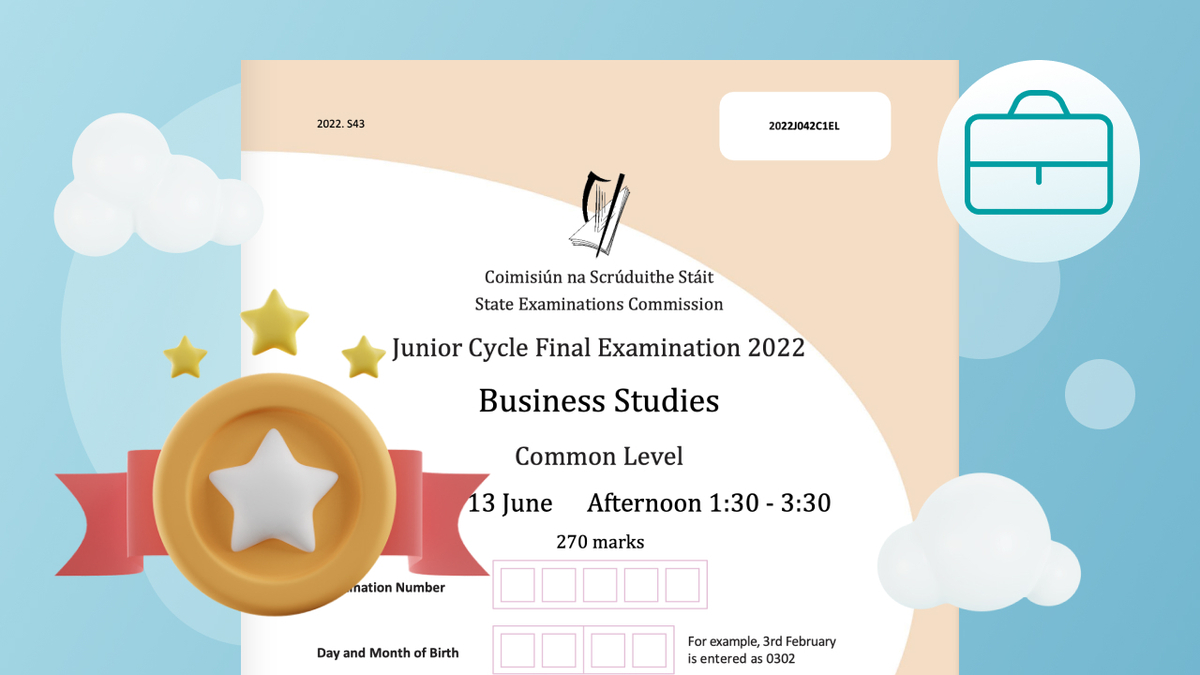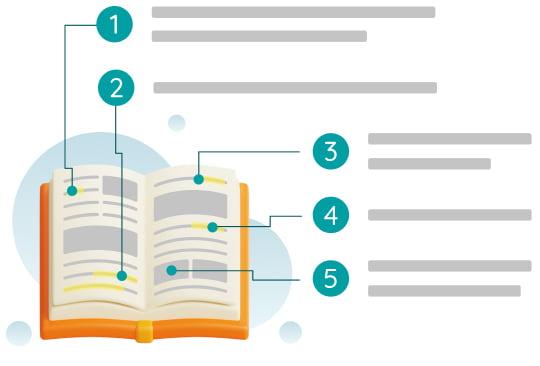The new Junior Cycle Business Studies course is designed to help you develop personal skills such as research and communication. This guide will bring you through what to expect with some helpful tips and advice.
How to get a Distinction in Junior Cycle Business Studies
 By Cillian N. - 10 minute read
By Cillian N. - 10 minute readIn this guide, student Cillain N. shares the tips and tricks that helped him receive a distinction in Junior Cycle Business Studies.

Jump to:
Introduction

Classroom-Based Assessments
You will complete 2 Classroom-Based Assessments (CBAs) throughout this course and for each one, you will be awarded one of the following descriptors:
Exceptional
Above expectations
In line with expectations
Yet to meet expectations

CBA 1
The CBA 1 is a group project completed in 2nd year, based on one of the following areas:
Enterprise in Action
Economics in Action
Finance in Action
For CBA 1, my group decided to complete a project based on Enterprise in Action. For this area, we had to conduct market research on a product or service of our choice. We had to investigate our competitors’ prices, the demand for our product, the price at which we could source them and so on.
After you have conducted your research (a mixture of field and desk research), your teacher will give you a student research template that you must complete. This outlines the research you carried out and each student in the group must complete this worksheet individually.
It is important that your group keeps a record of everything you do including who you spoke to, the websites that you used, the emails you sent and the replies you received, etc.

CBA 2
CBA 2 is an individual presentation. You can choose any topic you want as long as it is related to the business environment. I chose to do my topic on the effect of globalisation on local businesses and communities. There are three parts to this CBA:
Investigating
Reflecting on your learning
Communicating
Your presentation should last approximately 3 minutes, including some time set aside for engaging with the audience (Q&A).

Your presentation
In your presentation, make sure to:
Give the audience a brief overview of your chosen topic.
Explain why you have an interest in the topic.
Outline what you have learned.
Reflect on whether or not you view the topic differently now.
Give your opinion.
I know it may be difficult and nerve-racking to stand up in front of your classmates and present your project but try to sound as confident as possible and fluctuate the tone of your voice to help keep the audience interested. You will feel much better having presented your project.

The Assessment Task
The Assessment Task is based on your CBA 2 and is worth 10% of your overall grade. Fortunately, the questions on the Assessment Task can be viewed online so you’ll have a bit of a head start before you actually do it. The Assessment Task can ask you questions like:
What have you learned?
What are your strengths?
What changes would you make if you were to do it again?
How has your perspective changed?
What material supports your information (statistics, etc.)?
Provided you did a lot of work for your CBA 2, you should be capable of doing well here and achieving as close to the 10% as possible.

Final exam
This exam is worth 90% of your overall grade. It is two hours long and there are two sections to answer (A and B). Section A consists of short answer questions while Section B contains slightly longer answer questions. Let's have a closer look:
Section A
For this section, make sure that you can put the information that you learned throughout your business studies course into real-life situations. For example, you may be asked to give advice to someone who has a budget deficit or to outline different sources of finance for various purchases. It is also important that you can distinguish between needs and wants and give examples of each. Overall, Section A shouldn’t cause you too much hassle provided you have the information learned, of course.
Section B
This section requires longer answers but in my opinion, it isn’t any harder than Section A. Make sure you can interpret graphs (particularly demand and supply curves) and it is worth practicing these in your exam papers to help you get a better understanding of them. You should also familiarise yourself with consumer rights and responsibilities, as well as advice on how to shop safely online. For me, the accounts section was the one that I dreaded the most but if you practice them enough, you’ll have no bother doing them on the day.
You will have to develop your answers in this section if you want to maximise your marks but this isn’t too difficult once you get used to doing it.

Question breakdown
Section B can also include an analysed cash book, a general ledger and a trial balance. At first, I found these accounts very confusing but after a bit of practice, I had no trouble doing them. I will give you a brief run-through of each of the accounts to help you understand them better.

Analysed cash book
For the analysed cash book, put the money going into the business (income) into the left-hand side of the account (debit side) and put all the expenditure into the right-hand side of the account (credit side). Here is the process for answering this type of question:
| Step 1 | For figures such as sales and purchases, the question may state to add VAT at 13.5%. For example, sales of 12,000 plus VAT @ 13.5%. For this, add the 13.5% of VAT to 12,000 (13,620) and put this figure into the bank column. Then, in the sales column, put in 12,000. |
| Step 2 | Put the VAT of 1,620 into the VAT column. |
| Step 3 | When you have the figures inserted into their respective sides and particular columns, add up the bank columns of each side (I used to write the total for each side at the side of the exam paper for handiness sake until I knew which was the greater figure). |
| Step 4 |
Usually, the total for the left-hand side is bigger than the total for the right-hand side. Whichever figure is bigger, enter it into the total box in its side. For example, if the total of the left-hand side is bigger, enter it into the total box on the left side. Don’t enter the figure from the right-hand side yet. |
| Step 5 | Next, subtract the two figures from each other and enter the answer into the bank column on the right side. Call this figure balance c/d. |
| Step 6 | Enter the total from the left-hand side into the total box on the right-hand side (both totals are now the same). |
| Step 7 | Finally, enter the figure you got when you subtracted both figures (same figure as balance c/d) underneath the total on the left side. Call this balance b/d. |

General ledger
The most important thing to remember for the general ledger is that if it’s on the right side of the cash book, it’s on the left side of the general ledger. For example, purchases are on the right side of the cash book but they are on the left side of the general ledger. Here is the process for answering this type of question:
| Step 1 | Enter the purchase figure into the left side of the general ledger. |
| Step 2 |
The general ledger for VAT is a little less straightforward:
|
| Step 3 | Enter the balance of the two figures (i.e. either VAT purchases, VAT sales or VAT sales, VAT purchases, depending on which figure is greater). |
| Step 4 | The figure on the side that has the smallest value should be called balance c/d. |
| Step 5 | Make sure that the totals on both sides are equal. |
| Step 6 | Enter the balance beneath the total of the side that has the greatest value (balance b/d). |
The accounts are a lot to take in but practice makes perfect. Have a look at the marking scheme for the analysed cash book and general ledgers for the 2019 paper if you want to get a better understanding of the accounts.

Trial balance
In my opinion, the trial balance is the easiest account. It's simply using the same figures from the general ledger. With the trial balance, if it’s on the left side of the general ledger, it’s on the left side of the trial balance. Here is the process for answering this type of question:
| Step 1 | Enter the figures into either the left or right column on the trial balance, depending on where they are in the general ledger. |
| Step 2 | Add up the two columns and if you’ve done it correctly, both columns should equal each other. |

Best of luck! You will be great.

Cillian got a distinction in his Junior Cycle Business Studies.
